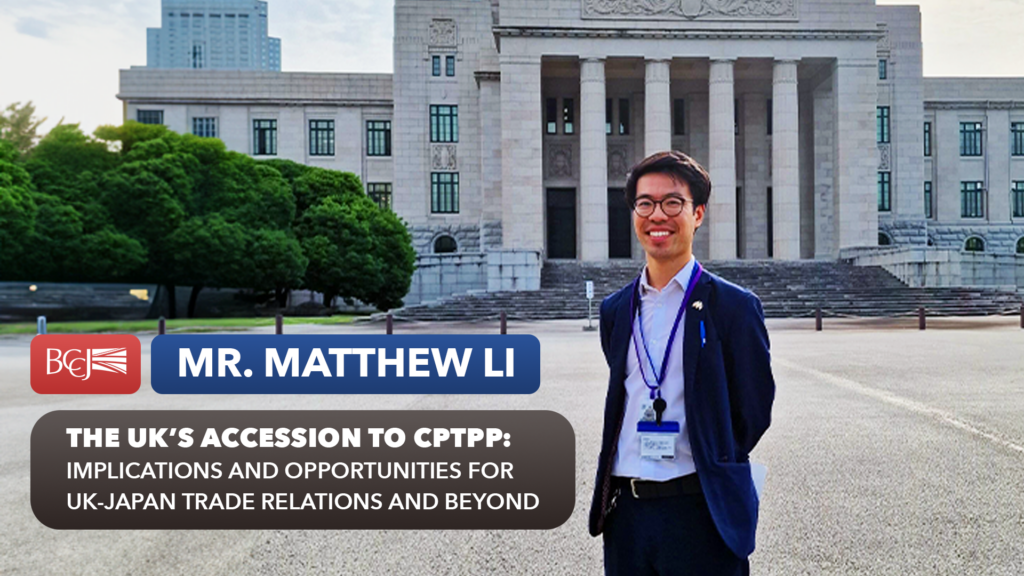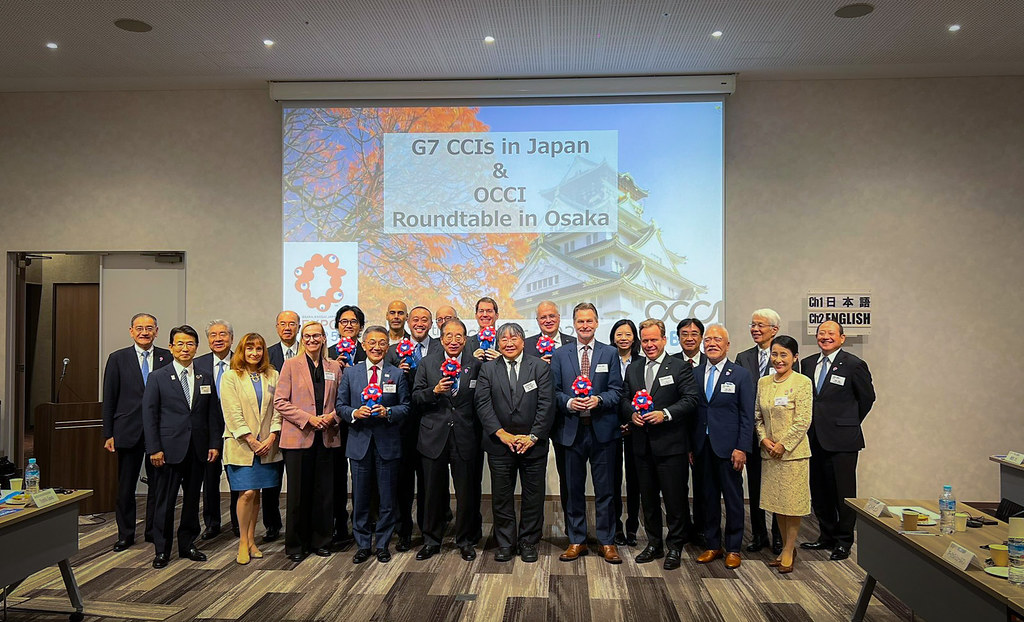Member? Please login
The UK’s Accession to CPTPP: Implications and Opportunities for UK-Japan Trade Relations and Beyond

Written by BCCJ
August 22, 2024
Community and Business
This interview was conducted and written by Tatsuki Sekiguchi, who is currently interning with the BCCJ.
Seasoned Trade Policy Expert at the Heart of UK-Japan Relations
Mr. Matthew Li serves as the Counsellor for Trade Policy at the British Embassy in Tokyo, a position he has held for nearly a year. With a strong background in trade negotiations, including crucial work on Brexit, Counsellor Li brings specialised expertise to his role in Japan. His career focus is firmly rooted in trade policy, and his current posting allows him to gain valuable experience in international trade diplomacy. Counsellor Li’s presence at the embassy exemplifies the blend of regional knowledge and subject-matter expertise that characterises modern diplomatic missions, and he stands out as the embassy’s leading authority on trade policy matters. His unique perspective and specialised knowledge make him an invaluable asset to the British Embassy’s efforts in navigating the complex landscape of UK-Japan trade relations and broader regional economic partnerships.
He is particularly well-positioned to discuss the UK’s recent accession to the Comprehensive and Progressive Agreement for Trans-Pacific Partnership (CPTPP). His insights on this significant trade agreement, its implications for UK-Japan trade relations, and its broader impact on the Asia-Pacific region are invaluable. Antonio Guillebeau, my fellow intern and I interviewed Counsellor Li to share his perspective (and writer’s own personal opinions and analyses) on how the CPTPP is shaping the UK’s trade strategy in the region and the opportunities it presents for both British and Japanese businesses from various perspectives.
Overview
CPTPP is a Free Trade Agreement (FTA) involving 11 economies in the Asia-Pacific region, including New Zealand, Australia, Brunei Darussalam, Canada, Chile, Japan, Malaysia, Mexico, Peru, Singapore, and Viet Nam. The agreement is termed ‘comprehensive and progressive’ as it offers not only deep tariff liberalisation, but also includes provisions liberalising trade in services and investment, as well as establishing contemporary regulatory frameworks across a broad spectrum of sectors, including intellectual property rights, financial services, e-commerce, and governance mechanisms for state-owned enterprises.
The UK’s journey to join the CPTPP has progressed through several key stages:
- Formal Negotiations Begin: 2 June 2021
- Negotiation Conclusion: 31 March 2023
- Protocol of Accession Signing: 16 July 2023
- Expected Entry into Force: Second half of 2024 (pending completion of ratification processes by the UK and CPTPP Parties)
The CPTPP is based on the original Trans-Pacific Partnership (TPP) signed in 2016, with some provisions suspended. It incorporates the TPP text by reference. The UK’s Protocol of Accession to the CPTPP is available here for reference, detailing the terms of the UK’s entry into the partnership. Also, you can see the UK government’s position on the strategic approach to CPTPP accession here.
Expanding Opportunities
CPTPP Benefits Beyond the Comprehensive Economic Partnership Agreement (CEPA)
Counsellor Li pointed out three angles of additional benefits of CPTPP beyond the UK-Japan CEPA.
1. Enhanced Market Access
He captures the first of three angles that in some areas, the CPTPP offers more advantages than the existing UK-Japan CEPA. For instance, in terms of dairy market access, the CPTPP provides larger tariff quotas compared to CEPA, allowing for increased trade in dairy products between the UK and Japan. He also notes that whilst the bilateral UK-Japan CEPA is already quite comprehensive (liberalising 99% of tariffs), the CPTPP still manages to offer some additional benefits in certain sectors. CPTPP also offers new market access to Malaysia and Brunei, with which the UK did not previously have free trade agreements.
2. Supply Chain Flexibility
Counsellor Li secondly highlighted the ability to ‘accumulate’ across CPTPP member countries as one of the major benefits of CPTPP, which relates to the ‘Rules of Origin’ chapter in trade agreements. The ‘Rules of Origin’ primarily determine when a product can be considered as originating from a specific country, which is crucial for applying preferential tariffs in trade agreements. Under CPTPP, a UK or Japanese manufacturer can source components from any of the 12 CPTPP member countries and still have the final product qualify as ‘British’ for trade purposes. For instance, a car assembled in the UK could utilise an engine from Mexico, wheels from Australia, and still be considered British, provided it meets the required threshold of CPTPP-originating content (45% for automobiles; different products have different thresholds for determining origin within the CPTPP framework). This advantage is termed the ‘accumulation benefit,’ which also allows for more complex supply chains and offers UK businesses the opportunity to flexibly diversify their supply chains by sourcing components from various CPTPP member countries whilst still qualifying for tariff-free trade within the CPTPP market. Depending on their supply chain structure, UK manufacturers may choose between trading under CPTPP or the bilateral agreement when exporting to Japan. If supply chains are predominantly EU-focused, the bilateral agreement might be more advantageous as EU components can be counted as British. The same product with EU-heavy components might not qualify as British under CPTPP rules.
The UK-Japan Bilateral Free Trade Agreement (FTA) allows EU components in UK goods to count as originating, but only unilaterally from Japan’s side. This accumulation with the EU is not possible under CPTPP due to the lack of an EU-CPTPP trade agreement. Therefore, UK car manufacturers with EU-heavy supply chains may find the bilateral UK-Japan FTA more advantageous when exporting to Japan. Conversely, manufacturers looking to source components from non-EU countries may benefit more from CPTPP. These considerations apply to all manufactured goods with complex supply chains, not just the automotive industry.
In summary, CPTPP membership helps UK manufacturers diversify their supply chains by providing more options for sourcing components. Even with existing bilateral agreements, CPTPP gives UK manufacturers additional flexibility in supply chain management and export strategies. So, the complexity of trade agreements means UK businesses now have more options to optimise their sourcing and exporting strategies.
3. Strategic and Geopolitical Considerations (1)
Counsellor Li highlighted, as the third angle, that the UK’s decision to join CPTPP was not solely based on immediate business benefits, but also on broader geoeconomic and geopolitical considerations. He noted that the Indo-Pacific region is seen as a key area for future economic growth opportunities. CPTPP membership gives the UK a seat at the table where trade rules for the region are designed, allowing input in rule-making through processes such as the General Review. This participation enables the UK to help ensure that new rules work for British businesses.
Thus, CPTPP membership allows the UK to support British businesses by influencing future trade rules to work in their favour and helps prevent the creation of unintended trade barriers that could arise from new trade policies.
He also discussed how the UK’s approach to CPTPP has parallels with its historical approach to trade blocs, including its earlier involvement with European Free Trade Association (EFTA) and debates around joining the European Economic Community (EEC) in the 1970s. The UK government views CPTPP membership as an opportunity to deepen relations with countries in the Asia-Pacific region, supporting broader UK foreign policy objectives including military and defence interests, strengthening economic and political ties, and collaboration on issues like climate change. In addition, he emphasised that CPTPP is designed for expansion and upgrades, making it an attractive platform for future trade relationships. Currently, six economies have formally applied to join CPTPP -China, Taiwan, Ecuador, Uruguay, Ukraine and Costa Rica. Several others, including South Korea, Indonesia, and the Philippines have also expressed interest in joining CPTPP.
The United States and CPTPP
Japan has publicly stated its objective to bring the U.S. back into the CPTPP. The UK currently does not have a free trade agreement with the U.S., its biggest bilateral trading partner. Previous UK-US bilateral trade negotiations began after Brexit under the Trump administration. Counsellor Li informed me that he was part of the UK negotiation team working with the U.S. negotiation team led by Robert Lighthizer, former U.S. Trade Representative. However, negotiations stalled when the Biden administration came into office, as they were not pursuing new free trade agreements with any countries.
It is likely that any UK government would likely be interested in deepening trade relations with the U.S., whether through a bilateral FTA or CPTPP. He noted, ‘If the U.S. were to apply to join CPTPP, it would require negotiations’. Additionally, CPTPP members have collectively agreed on criteria for assessing future accessions (more details in the next paragraph below), which would also apply to the U.S. like any other applicant to CPTPP. However, given the current domestic politics of the U.S. it seems we cannot expect the U.S. to apply to join CPTPP in the near future.
CPTPP Accession Process
CPTPP is a consensus-based agreement, with decisions made collectively rather than by individual or larger members. Trade Ministers from CPTPP members have agreed on three main criteria for assessing new applicants:
1. Commitment to Trade Obligations
– Does the applicant have a track record of fulfilling its trade commitments?
– Do they meet their WTO obligations?
2. CPTPP Standards
– Can they comply with the CPTPP treaty text commitments?
– Can they meet the tariff liberalisation rates (ideally 99% liberalisation)?
3. Consensus amongst CPTPP Parties
– All current CPTPP members must agree to accept the new applicant.
These criteria are being applied to the current six applicants and will be used for any future applicants, including the U.S. if it were to apply. Once CPTPP members decide by consensus to take forward a candidate for accession, the formal negotiations begin in earnest.
The UK’s accession process involved two stages. One is what is called a compliance process where CPTPP parties assessed the UK’s ability to comply with each chapter’s commitments. The other is the market access negotiation to determine the liberalisation in goods, services, investment, and procurement that the UK would offer. For the UK’s accession, negotiations took around two years from the point that CPTPP members agreed to launch accession negotiations to the point of signing the final agreement.
Strategic Importance and UK-Japan Role in CPTPP
Strategic and Geopolitical Consideration (2)
Following the UK’s departure from the European Union, it gained the ability to negotiate new Free Trade Agreements, such as accession to CPTPP. These trade deals can provide UK businesses with a competitive trading advantage over businesses from other countries that do not have Free Trade Agreements with shared trading partners. The UK undoubtedly believes the CPTPP will bolster trade and investment in key sectors of its economy, particularly services. The CPTPP’s provisions facilitate easier business travel and trade, which will benefit the UK’s substantial services-based economy.
Furthermore, given the limited progress of rule-making at the World Trade Organisation, CPTPP can be viewed as a potential alternative forum for shaping trade rules. Many of the provisions in CPTPP have become precedent for other Free Trade Agreements across the world, meaning they will be familiar to businesses in CPTPP countries.
As the 6th largest economy globally, the UK’s presence in the CPTPP will increase the bloc’s economic size by 25%. ‘Hopefully, the UK, with a market of 68 million consumers, is quite an attractive member for supporting the objective of CPTPP countries looking to diversify their trade and investment beyond Asia-Pacific,’ states Counsellor Li.
Japan’s Central Role in UK’s CPTPP Accession
Japan played a crucial role as the chair of the UK’s accession working group, coordinating efforts amongst the CPTPP parties to support the UK’s accession. Japan was particularly keen on the UK joining the CPTPP, viewing the UK as a like-minded country, and sought to expedite the UK’s membership.
The notion of the UK being a ‘like-minded country’ in the context of joining the CPTPP primarily refers to the alignment of economic systems and approaches to the rules-based trading system. CPTPP member countries are generally market economies with similar commitments to free and fair trade based on international rules and norms. This similarity in economic philosophy and approach to trade was deemed beneficial by Japan in having the UK join the CPTPP.
Japan likely perceived the UK as a natural fit and ally within the trade bloc, sharing common perspectives on the importance of the rules-based trading system underpinning the CPTPP. Beyond economic alignment, Japan may have also recognised strategic value in the UK’s membership, given the UK’s ‘special relationship’ and influence with the U.S.
Thus, Japan’s support for UK accession was driven by both economic compatibility and potential geopolitical advantages. Japan played a significant role in facilitating negotiations and maintaining momentum, whilst the UK ensured the accession process continued smoothly.
Safeguarding the Rule-Based Economic Order
The UK and Japan, as substantial developed market economies, are endeavouring to uphold the rules-based international economic order amidst growing great power rivalry, particularly notable in the recent world. This rivalry can at times prove detrimental to the economic interests of countries like the UK and Japan.
A pertinent example is the steel tariffs imposed by the Trump administration in 2018, claimed to be for national security reasons, which affected not just China but also U.S. allies such as the UK and Japan. This compelled these middle powers to hastily negotiate their own separate deals with the U.S., rather than being able to rely on a united approach through larger blocs like the EU.
Consequently, the UK and Japan recognise the importance of coordinating amongst themselves, other similarly-situated economies and the ‘like-minded countries’ to avoid being singled out individually by the major powers when economic conflicts arise. The CPTPP views maintaining the integrity of the rules-based trading system, as embodied by institutions like the WTO, as crucial to safeguarding their economic interests in the face of great power rivalry and unilateral actions that can undermine the global economic order.
Non-Tariff Barriers and National Sovereignty
The CPTPP includes provisions that facilitate the mutual recognition of conformity assessments, allowing products to be tested and certified for standards in the exporting country before being exported, rather than requiring testing in the importing country. This could save companies significant costs that would arise from having to ship products to the importing country for testing and certification.
CPTPP also has transparency and notification requirements, obligating members to be transparent about any new technical regulations they introduce and provide comment periods. This enables other member countries to be aware of proposed new rules and raise any concerns before the regulations are finalised, helping to prevent the creation of unintended non-tariff barriers. Additionally, the CPTPP encourages its members to base their technical regulations on international standards wherever possible, helping reduce diversity in product requirements, which is a common source of non-tariff barriers to trade.
However, unlike the EU, the CPTPP does not have a framework to create more common, harmonised standards across the trade bloc. Each individual member country retains the sovereign right to design its own regulations and technical standards. Instead, the CPTPP aims to make it easier for companies to meet the various standards set by each CPTPP member country.
This approach preserves the national sovereignty of CPTPP members over their regulatory frameworks. The CPTPP’s approach aims to facilitate trade within diversity, rather than require deep harmonisation of standards.
Vision for CPTPP
Modernisation
The CPTPP framework and discussions surrounding future accessions will be a powerful instrument for advancing the UK’s collective objectives, as well as its specific goals in the Indo-Pacific region. The General Review process, which serves as the formal vehicle for upgrading the CPTPP, is designed to evaluate the Agreement’s performance with a view to updating and enhancing it to ensure it remains of the highest possible standard for trade agreements. In this context, there are opportunities to upgrade the CPTPP agreement in several areas:
Digital Trade
Digital trade underpins a significant portion of business transactions across various sectors, not just in services, but also goods. However, the CPTPP currently lacks references to modern digital trade practices and technologies like AI. The UK, as a leader in AI, is keen to see the digital trade provisions upgraded to better reflect current realities.
Environment
There have been significant advancements in how trade agreements can support environmental objectives. For instance, the UK has negotiated with New Zealand to include references to the Paris climate agreements, environmental goods and services, and how trade can support the circular economy. The UK sees opportunities to incorporate more of these modern environmental provisions into the CPTPP.
Supply Chain Resilience
This is another area the UK and other CPTPP parties are interested in exploring further within the CPTPP framework.
The UK government is very intentional about incorporating input from the business community to help shape its priorities for the CPTPP review process. Working closely with British Chamber of Commerce (BCCJ) members like Richard Lyle, who is the president of BCCJ and Government Relations Task Force, the government gathers feedback and insights from UK businesses. The views and priorities of the business sector are very important and influential inputs in determining the UK’s position and approach to the CPTPP going forward.
Collaboration with Japan
The UK and Japan already maintain numerous direct bilateral dialogues and mechanisms for cooperation, including the committees of the UK-Japan CEPA, as well as those on economic security, digital issues, and energy.
For example, regarding offshore wind, the UK is employing its bilateral CEPA committee structures, outside of the CPTPP, to share expertise and support Japan’s design of its offshore wind energy markets. Despite the fact that the UK’s accession to CPTPP is not yet ratified, the UK is leveraging these alternative committee forums to support Japan on this specific issue of offshore wind market development, including through the offer that UK business can provide. Thus, in this instance, the UK is using avenues separate from the CPTPP committees to collaborate with Japan on this particular industry and policy area, rather than relying on the CPTPP framework.
The UK’s collaboration with Japan exemplifies a multi-faceted approach to international cooperation and trade relations, and ‘The UK and Japan are already cooperating significantly, and CPTPP will surely provide another such opportunity for further collaboration,’ stresses Counsellor Li.
Preserving Global Economic Order
‘We are increasingly seeing the dysfunction at the WTO leading to increased trade conflict and unilateral actions by the major powers. This is fracturing the global trading system,’ warns Counsellor Li. The UK and Japan view the WTO as the bedrock of the global trading order, thus they are concerned about this breakdown.
Particularly when a major power takes unilateral actions, it puts the UK and Japan in a difficult position, as they get caught in the ‘crossfire’ between the big players. As a result, the UK and Japan feel an increasing need to work together to advocate for the importance of free trade and multilateral rule-making.
The UK and Japan hope that by coordinating their positions and jointly engaging with the big players in a framework such as CPTPP, they can be more effective in making the case for preserving the rules-based global trading system, rather than acting individually. The UK and Japan’s shared G7 membership also potentially provides a platform for this kind of collaborative approach.
Post-Brexit Trade Strategy: Other Deals
Rollover and Upgrade
Since leaving the EU, the UK has signed 73 trade deals, a large number of which were so-called rollover agreements from existing EU arrangements. Whilst much was carried over, some areas need to be upgraded.
The two significant new free trade negotiations concluded since Brexit are the bilateral free trade agreements with Australia and New Zealand. These deals have provided certain benefits that the UK doesn’t get through the CPTPP, and vice versa. The UK also has ongoing, near-conclusion negotiations for an FTA with India. Additionally, the UK is negotiating with the Gulf Cooperation Council (GCC), a bloc of six Gulf states. The UK is finding that it can sometimes obtain certain trade and supply chain benefits through these bilateral agreements that it doesn’t secure through the CPTPP framework.
The UK has almost rolled over some existing trade agreements it had as an EU member but is now looking to ‘upgrade’ the terms of these deals. The ‘upgrade negotiations’ allow the UK to take the existing frameworks and adapt them to incorporate more modern provisions and address changes in the economy and trade landscape since the original agreements were signed. For example, the UK is negotiating an upgraded trade agreement with South Korea, as the original EU-Korea deal dates back to 2010 and the UK wants to modernise the terms. The UK is also in the process of negotiating upgraded trade deals with Turkey, Switzerland and Israel (as of June 2024).
‘Special Relationship’ with the U.S.
The UK had been negotiating a free trade agreement with the U.S., but the Biden Administration is currently not pursuing any new FTA negotiations. Instead, the UK has been engaged in various other federal-level agreements with the U.S., including the Atlantic Declaration signed by the UK Prime Minister and President Biden, and the resolution of trade disputes, such as on s.232 steel tariffs, and the Boeing-Airbus dispute. The UK is also actively negotiating Memoranda of Cooperation (MoC) with individual U.S. states, such as the recent one with Texas. This includes negotiating with states like California, which has the same size economy as the UK. Whilst these state-level MoCs are not binding FTAs and don’t liberalise tariffs, they help create commercial opportunities that UK businesses are seeking. Furthermore, this state-level engagement is important because in the U.S. system, a lot of power is delegated to the states, including in areas like procurement, which would normally be part of an FTA. So, the UK has been pursuing this dual-track approach of federal-level agreements alongside state-level MoCs to advance its economic interests in the U.S. market, given the inability to negotiate a full FTA at this time.
Conclusion
The UK’s accession to the CPTPP marks a significant milestone in its post-Brexit trade strategy, offering substantial economic advantages for both British and Japanese businesses. The agreement’s enhanced market access and flexible ‘Rules of Origin’ provide UK companies with unprecedented opportunities to diversify their supply chains and expand into lucrative Indo-Pacific markets. For Japanese firms, the UK’s entry brings a valuable European partner into the fold, potentially opening new avenues for investment and collaboration in sectors such as financial services, advanced manufacturing, and technology. The partnership’s provisions on digital trade, intellectual property, and state-owned enterprises create a modern framework that benefits innovative companies in both countries.
Beyond these immediate economic gains, the UK-Japan alliance within CPTPP positions both nations to influence future trade rules, addressing emerging challenges in areas like AI and green technology. As the global trade landscape evolves, the UK’s strategic positioning in CPTPP, coupled with its strong bilateral ties with Japan, promises to yield long-term economic benefits for businesses on both sides, while contributing to the resilience and stability of the international trading system.
Lastly, I extend my deepest gratitude to Counsellor Li for his invaluable story. His willingness to share his knowledge and experiences has provided a unique and authoritative perspective on these complex issues, significantly enhancing my understanding of the opportunities and challenges that lie ahead in this new era of international trade. And it is my sincere hope that this report proves useful to Japanese companies considering a business with British, serving as a valuable resource for a broad and insightful understanding of the CPTPP and the strategic rationale behind the UK’s decision to join. By comprehending the UK’s motivations and the potential synergies between UK and Japanese businesses within this framework, I believe Japanese firms can better position themselves to make use of the opportunities presented by this expanded partnership.







